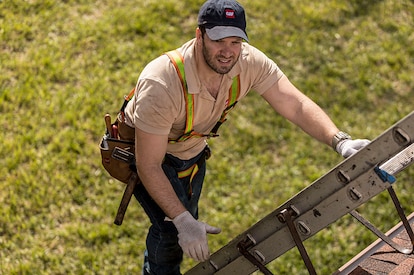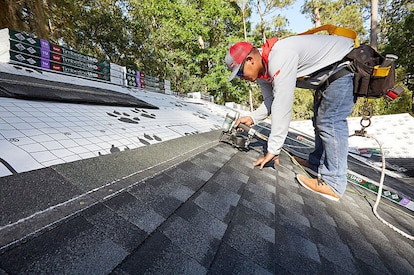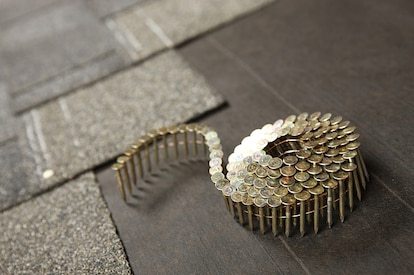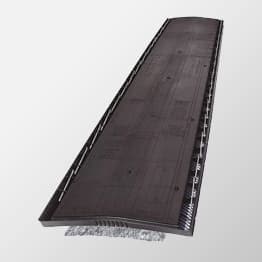
Calculateur de ventilation
Comment calculer
Étape 1 : Mesurer
Étape 2 : Calculer
Étape 3 : Identifier
Commencer
Utilisez ce calculateur pour connaître la ventilation de grenier nécessaire selon les directives 1/300 de la FHA aux É.-U.
Suggestions pour une surface de 900 pi2
Remarque :
Ventilation d'évacuation
| Produit | Pieds linéaires requis |
|---|---|
| CobraMD RidgeRunnerMD | 31 pi |
| CobraMD Rigid Vent 3MC | 22 pi |
| CobraMD SnowCountryMD | 22 pi |
| CobraMD SnowCountryMD Advanced | 22 pi |
| Cobra® Hip Vent | 43 pi |
| TruSlateMD Évent de faîte | 43 pi |
Produit
CobraMD RidgeRunnerMD
Pieds linéaires requis
31 pi
Produit
CobraMD Rigid Vent 3MC
Pieds linéaires requis
22 pi
Produit
CobraMD SnowCountryMD
Pieds linéaires requis
22 pi
Produit
CobraMD SnowCountryMD Advanced
Pieds linéaires requis
22 pi
Produit
Cobra® Hip Vent
Pieds linéaires requis
22 pi
Produit
TruSlateMD Évent de faîte
Pieds linéaires requis
22 pi
| Produit | Pieds linéaires requis |
|---|---|
| Évent d'aération CobraMD – installation au marteau | 31 pi |
| Évent d'aération CobraMD – installation à la cloueuse | 22 pi |
Produit
Évent d'aération CobraMD – installation au marteau
Pieds linéaires requis
31 pi
Produit
Évent d'aération CobraMD – installation à la cloueuse
Pieds linéaires requis
22 pi
| Produit | Pieds linéaires requis |
|---|---|
| AR10 | 31 pi |
Produit
AR10
Pieds linéaires requis
31 pi
| Produit | Nombre requis |
|---|---|
| RT65 – dessus carré en plastique | 31 |
| Évent en plastique -arrière incliné 61 IR | 31 |
| Utilitaire métallique R50/RV50 | 31 |
| Évent en plastique -arrière incliné 65 IR | 31 |
| SSB960 métal très incliné – arrière | 31 |
| Évent pour dôme à grande capacité HCD144 | 31 |
Produit
RT65 – dessus carré en plastique
Nombre requis
31
Produit
Évent en plastique -arrière incliné 61 IR
Nombre requis
31
Produit
Utilitaire métallique R50/RV50
Nombre requis
31
Produit
Évent en plastique -arrière incliné 65 IR
Nombre requis
31
Produit
SSB960 métal très incliné – arrière
Nombre requis
31
Produit
Évent pour dôme à grande capacité HCD144
Nombre requis
31
Ventilation d'entrée
| Produit | Pieds linéaires requis |
|---|---|
| Cobra IntakeProMD | 31 pi |
Produit
Cobra IntakeProMD
Pieds linéaires requis
31 pi
Produit
Évent de panneau CobraMD (rouleau de grillage) 1 po
Pieds linéaires requis
22 pi
Produit
Évent de panneau CobraMD (rouleau de grillage) 1,5 po
Pieds linéaires requis
22 pi
| Produit | Nombre requis |
|---|---|
| Évents de soffite continuels LSV8 en métal (pieds linéaires) | 31 pi |
| Évents de sous-face en plastique EAP 4 x 12 | 31 |
| Évents de sous-face en métal EAP 16 x 4 | 31 |
| Évents de sous-face en métal EAP 16 x 8 | 31 |
| Évents de sous-face refermables EmberShieldMD | 31 |
Produit
Évents de sous-face continus LSV8 en métal
Nombre requis
31
Produit
Évents de sous-face en plastique EAP 4 x 12
Nombre requis
22
Produit
Évents de sous-face en métal EAP 16 x 4
Nombre requis
22
Produit
Évents de sous-face en métal EAP 16 x 8
Nombre requis
22
Produit
Évents de sous-face refermables EmberShieldMD
Nombre requis
22
Aération d'entrée ou d'évacuation
Remarque : L'installation des ventilateurs de pignon se fait habituellement par paire.
| Produit | Nombre requis |
|---|---|
| DA 12x12 | 31 |
| DA 12x18 | 31 |
| DA 14x24 | 31 |
| DA 18x24 | 31 |
| DA 24x30 | 31 |
Produit
DA 12x12
Nombre requis
31
Produit
DA 12x18
Nombre requis
31
Produit
DA 14x24
Nombre requis
31
Produit
DA 18x24
Nombre requis
32
Produit
DA 24x30
Nombre requis
33
| Produit | Nombre requis |
|---|---|
| SL 8x8 | 31 |
| SL 12x12 | 31 |
| SL 12x18 | 31 |
| SL 18x24 | 31 |
Produit
SL 8x8
Nombre requis
34
Produit
SL 12x12
Nombre requis
35
Produit
SL 12x18
Nombre requis
36
Produit
SL 14x24
Nombre requis
37
Produit
SL 18x24
Nombre requis
38
| Produit | Nombre requis |
|---|---|
| RLSC 2 po | 31 |
| RLSC 3 po | 31 |
| RLSC 4 po | 31 |
Produit
RLSC 2 po
Nombre requis
39
Produit
RLSC 3 po
Nombre requis
40
Produit
RLSC 4 po
Nombre requis
41
Ventilation d'évacuation
| Produit | Nombre requis |
|---|---|
| ERV4 | 31 |
| ERV5 et Wi-Fi ERV5QCT | 22 |
| ERV6 | 22 |
| EZ CoolMC EZCR1 | 22 |
Produit
ERV4
Nombre requis
31
Produit
ERV5 et Wi-Fi ERV5QCT
Nombre requis
22
Produit
ERV6
Nombre requis
31
Produit
EZ CoolMC EZCR1
Nombre requis
31
| Produit | Nombre requis |
|---|---|
| EGV5 et Wi-Fi EGV5QCT | 31 |
| EGV6 | 22 |
| EZ CoolMC EZCG1 | 22 |
Produit
EGV5 et Wi-Fi EGV5QCT
Nombre requis
31
Produit
EGV6
Nombre requis
31
Produit
EZ CoolMC EZCG1
Nombre requis
31
| Produit | Nombre requis |
|---|---|
| Toiture solaire et à double alimentation (ERVSOLAR / ERVHYBRID) | 31 |
| Pignon à énergie solaire (PGSOLAR) | 22 |
| Toiture solaire haute performance et bimode (PRSOLAR2/PRHYBRID2) | 22 |
Produit
Toiture solaire et à double alimentation (ERVSOLAR / ERVHYBRID)
Nombre requis
31
Produit
Pignon à énergie solaire (PGSOLAR)
Nombre requis
31
Produit
Toiture solaire haute performance et bimode (PRSOLAR2/PRHYBRID2)
Nombre requis
31
| Produit | Nombre requis |
|---|---|
| 12" | 31 |
| 14" | 22 |
Produit
12"
Nombre requis
31
Produit
14"
Nombre requis
31
Ventilation d'entrée
| Produit | Pieds linéaires requis |
|---|---|
| avec ERV4 | 31 pi |
| avec ERV5 et Wi-Fi ERV5QCT | 22 pi |
| avec ERV6 | 31 pi |
| avec EZ CoolMC EZCR1 | 31 pi |
| avec EGV5 et Wi-Fi EGV5QCT | 22 pi |
| avec EGV6 | 31 pi |
| avec EZ CoolMC EZCG1 | 31 pi |
| avec toiture à énergie solaire et bimode | 22 pi |
| avec pignon à énergie solaire | 22 pi |
| Avec toiture solaire haute performance et bimode | 22 pi |
| avec turbine éolienne de 12 po | 22 pi |
| avec turbine éolienne de 14 po | 22 pi |
Produit
avec ERV4
Pieds linéaires requis
31 pi
Produit
avec ERV5 et Wi-Fi ERV5QCT
Pieds linéaires requis
31 pi
Produit
avec ERV6
Pieds linéaires requis
31 pi
Produit
avec EZ CoolMC EZCR1
Pieds linéaires requis
31 pi
Produit
avec EGV5 et Wi-Fi EGV5QCT
Pieds linéaires requis
31 pi
Produit
avec EGV6
Pieds linéaires requis
31 pi
Produit
avec EZ CoolMC EZCG1
Pieds linéaires requis
31 pi
Produit
avec toiture à énergie solaire et bimode
Pieds linéaires requis
31 pi
Produit
avec pignon à énergie solaire
Pieds linéaires requis
31 pi
Produit
Avec toiture solaire haute performance et bimode
Pieds linéaires requis
31 pi
Produit
avec turbine éolienne de 12 po
Pieds linéaires requis
31 pi
Produit
avec turbine éolienne de 14 po
Pieds linéaires requis
31 pi
| Produit | Pieds linéaires requis |
|---|---|
| avec ERV4 | 31 pi |
| avec ERV5 et Wi-Fi ERV5QCT | 22 pi |
| avec ERV6 | 31 pi |
| avec EZ CoolMC EZCR1 | 31 pi |
| avec EGV5 et Wi-Fi EGV5QCT | 22 pi |
| avec EGV6 | 31 pi |
| avec EZ CoolMC EZCG1 | 31 pi |
| avec toiture à énergie solaire et bimode | 22 pi |
| avec pignon à énergie solaire | 22 pi |
| Avec toiture solaire haute performance et bimode | 22 pi |
| avec turbine éolienne de 12 po | 22 pi |
| avec turbine éolienne de 14 po | 22 pi |
Produit
avec ERV4
Pieds linéaires requis
31 pi
Produit
avec ERV5 et Wi-Fi ERV5QCT
Pieds linéaires requis
31 pi
Produit
avec ERV6
Pieds linéaires requis
31 pi
Produit
avec EZ CoolMC EZCR1
Pieds linéaires requis
31 pi
Produit
avec EGV5 et Wi-Fi EGV5QCT
Pieds linéaires requis
31 pi
Produit
avec EGV6
Pieds linéaires requis
31 pi
Produit
avec EZ CoolMC EZCG1
Pieds linéaires requis
31 pi
Produit
avec toiture à énergie solaire et bimode
Pieds linéaires requis
31 pi
Produit
avec pignon à énergie solaire
Pieds linéaires requis
40 pi
Produit
Avec toiture solaire haute performance et bimode
Pieds linéaires requis
31 pi
Produit
avec turbine éolienne de 12 po
Pieds linéaires requis
31 pi
Produit
avec turbine éolienne de 14 po
Pieds linéaires requis
31 pi
| Produit | Nombre requis |
|---|---|
| avec ERV4 | 31 |
| avec ERV5 et Wi-Fi ERV5QCT | 22 |
| avec ERV6 | 31 |
| avec EZ CoolMC EZCR1 | 31 |
| avec EGV5 et Wi-Fi EGV5QCT | 22 |
| avec EGV6 | 31 |
| avec EZ CoolMC EZCG1 | 31 |
| avec toiture à énergie solaire et bimode | 22 |
| avec pignon à énergie solaire | 22 |
| Avec toiture solaire haute performance et bimode | 22 |
| avec turbine éolienne de 12 po | 22 |
| avec turbine éolienne de 14 po | 22 |
Produit
avec ERV4
Nombre requis
31
Produit
avec ERV5 et Wi-Fi ERV5QCT
Nombre requis
31
Produit
avec ERV6
Nombre requis
31
Produit
avec EZ CoolMC EZCR1
Nombre requis
31
Produit
avec EGV5 et Wi-Fi EGV5QCT
Nombre requis
31
Produit
avec EGV6
Nombre requis
31
Produit
avec EZ CoolMC EZCG1
Nombre requis
31
Produit
avec toiture à énergie solaire et bimode
Nombre requis
31
Produit
avec pignon à énergie solaire
Nombre requis
49
Produit
Avec toiture solaire haute performance et bimode
Nombre requis
31
Produit
avec turbine éolienne de 12 po
Nombre requis
31
Produit
avec turbine éolienne de 14 po
Nombre requis
31
| Produit | Nombre requis |
|---|---|
| avec ERV4 | 31 |
| avec ERV5 et Wi-Fi ERV5QCT | 22 |
| avec ERV6 | 31 |
| avec EZ CoolMC EZCR1 | 31 |
| avec EGV5 et Wi-Fi EGV5QCT | 22 |
| avec EGV6 | 31 |
| avec EZ CoolMC EZCG1 | 31 |
| avec toiture à énergie solaire et bimode | 22 |
| avec pignon à énergie solaire | 22 |
| Avec toiture solaire haute performance et bimode | 22 |
| avec turbine éolienne de 12 po | 22 |
| avec turbine éolienne de 14 po | 22 |
Produit
avec ERV4
Nombre requis
31
Produit
avec ERV5 et Wi-Fi ERV5QCT
Nombre requis
31
Produit
avec ERV6
Nombre requis
31
Produit
avec EZ CoolMC EZCR1
Nombre requis
31
Produit
avec EGV5 et Wi-Fi EGV5QCT
Nombre requis
31
Produit
avec EGV6
Nombre requis
31
Produit
avec EZ CoolMC EZCG1
Nombre requis
31
Produit
avec toiture à énergie solaire et bimode
Nombre requis
31
Produit
avec pignon à énergie solaire
Nombre requis
58
Produit
Avec toiture solaire haute performance et bimode
Nombre requis
31
Produit
avec turbine éolienne de 12 po
Nombre requis
31
Produit
avec turbine éolienne de 14 po
Nombre requis
31
| Produit | Nombre requis |
|---|---|
| avec ERV4 | 31 |
| avec ERV5 et Wi-Fi ERV5QCT | 22 |
| avec ERV6 | 31 |
| avec EZ CoolMC EZCR1 | 31 |
| avec EGV5 et Wi-Fi EGV5QCT | 22 |
| avec EGV6 | 31 |
| avec EZ CoolMC EZCG1 | 31 |
| avec toiture à énergie solaire et bimode | 22 |
| avec pignon à énergie solaire | 22 |
| Avec toiture solaire haute performance et bimode | 22 |
| avec turbine éolienne de 12 po | 22 |
| avec turbine éolienne de 14 po | 22 |
Produit
avec ERV4
Nombre requis
31
Produit
avec ERV5 et Wi-Fi ERV5QCT
Nombre requis
31
avec ERV6
Nombre requis
31
avec EZ CoolMC EZCR1
Nombre requis
31
avec EGV5 et Wi-Fi EGV5QCT
Nombre requis
31
avec EZ CoolMC EZCG1
Nombre requis
31
avec toiture à énergie solaire et bimode
Nombre requis
31
avec pignon à énergie solaire
Nombre requis
67
Avec toiture solaire haute performance et bimode
Nombre requis
31
avec turbine éolienne de 12 po
Nombre requis
31
avec turbine éolienne de 14 po
Nombre requis
31
| Produit | Nombre requis |
|---|---|
| avec ERV4 | 31 |
| avec ERV5 et Wi-Fi ERV5QCT | 22 |
| avec ERV6 | 31 |
| avec EZ CoolMC EZCR1 | 31 |
| avec EGV5 et Wi-Fi EGV5QCT | 22 |
| avec EGV6 | 31 |
| avec EZ CoolMC EZCG1 | 31 |
| avec toiture à énergie solaire et bimode | 22 |
| avec pignon à énergie solaire | 22 |
| Avec toiture solaire haute performance et bimode | 22 |
| avec turbine éolienne de 12 po | 22 |
| avec turbine éolienne de 14 po | 22 |
Produit
avec ERV4
Nombre requis
31
Produit
avec ERV5 et Wi-Fi ERV5QCT
Nombre requis
31
Produit
avec ERV6
Nombre requis
31
Produit
avec EZ CoolMC EZCR1
Nombre requis
31
Produit
avec EGV5 et Wi-Fi EGV5QCT
Nombre requis
31
Produit
avec EGV6
Nombre requis
31
Produit
avec EZ CoolMC EZCG1
Nombre requis
31
Produit
avec toiture à énergie solaire et bimode
Nombre requis
31
Produit
avec pignon à énergie solaire
Nombre requis
75
Produit
Avec toiture solaire haute performance et bimode
Nombre requis
31
Produit
avec turbine éolienne de 12 po
Nombre requis
31
Produit
avec turbine éolienne de 14 po
Nombre requis
31
Produits de ventilation de grenier et d'évent
Pour trouver la bonne solution de ventilation de grenier pour votre projet de toiture, choisissez parmi une gamme complète d'évents de faîte et de faîtière, d'évents électriques et solaires, de ventilateurs et de ventelles de pignon, de turbines éoliennes, d'évents d'entrée, et plus encore, tous proposés par GAF.

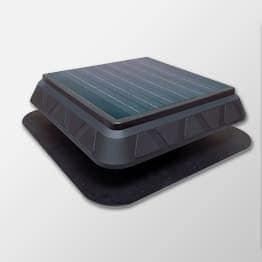
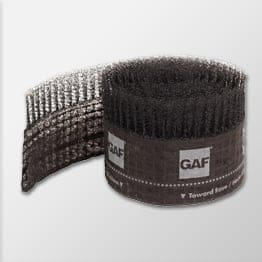
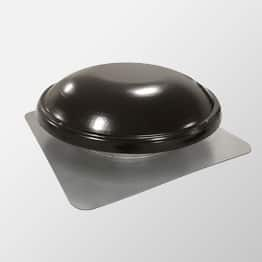


La règle 1/300 de ventilation de grenier équilibrée

Découvrez les options d'évents de grenier
Réponses à vos principales questions sur la ventilation de grenier

Comment ventiler un grenier – Fonctionnement de la ventilation du grenier | Toitures GAF

Comment choisir les produits pour votre système de ventilation du grenier | Toitures GAF

Comment planifier un système de ventilation de grenier équilibrée | Matériaux de toiture GAF

